If you've played more than once Carcassonneyou probably want to try something new and have even more fun. The Carcassonne expansion brings many new challenges, difficulties and excitement. Two Carcassonne expansions are mentioned in this article: 1. "Inns and cathedrals" (Inns & Cathedrals), bei 2. "Traders and builders" (Traders & Builders). Try them both.

Frequently asked questions
❓ What are the most popular Carcassonne expansions?
1. Inns & Cathedrals and 2. Traders & Builders are among the first additions to the games. They were the most popular in the world.
❓ What is the first Carcassonne expansion? What's new?
Inns & Cathedrals. This addition adds cards with cathedrals and cards with roadside inns. The set also includes a set of figures for the sixth player, six large subordinates of different colours and scoring cards.
❓ What is the second expansion for Carcassonne? What's new?
Traders & Builders. In this expansion you will find land cards with goods on them, goods cards, six builders, six piglets and a game bag.
Carcassonne Addendum - Inns and Cathedrals
Game set
- 8 pink subordinates
 and 1 pink abbot
and 1 pink abbot  . This is an addition to the pieces to allow one extra person to play;
. This is an addition to the pieces to allow one extra person to play; - 18 land cards:
- 6 eatery cards;
- 2 cathedral cards;
- 6 subordinate figures
 (higher than normal);
(higher than normal); - 6 cards with points. 50 points on the front of the card
 , 100 points on the back
, 100 points on the back 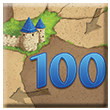 .
.
Game rules
All playing cards are turned over and shuffled. Play with as many additions as desired. It is important to be sure to use the base game. To help you distinguish between the cards in this expansion, each card has a subordinate badge on it. 
1. Placing the card
This action is done in the same way as in the base game.
2. Betting on a subordinate
This step is also done in the same way as in the basic version. It is important to remember that if you bet a larger piece, then its value is doubled. One larger subordinate piece is equal to two small pieces. The size of this piece has an impact when several players have placed their subordinates on the same fragment. In this case, the one with the larger number of pieces scores points. For example, if you have a large subordinate and your opponent has a small subordinate on one fragment, then you win. We count a large subordinate as two small ones.
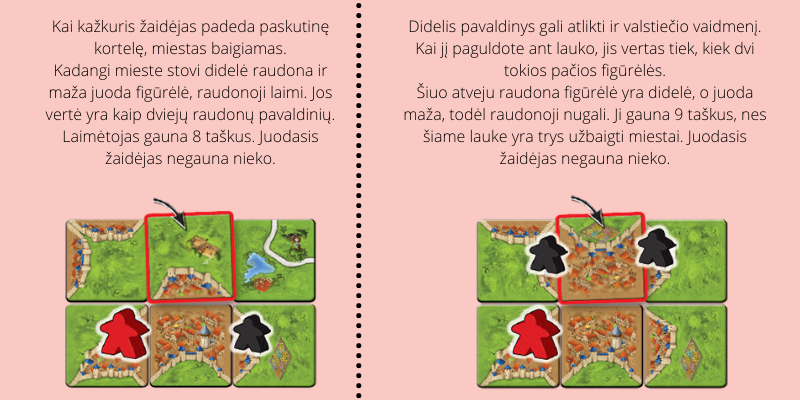
3. Points awarded for completed fragments
The road with the inn
- When a player completes a road adjacent to an inn, he receives not one but two points for each road card;
- When two or more pubs stand next to a completed road, two points are still awarded for each card;
- If you fail to complete the path with the inn, you do not get any points for it.
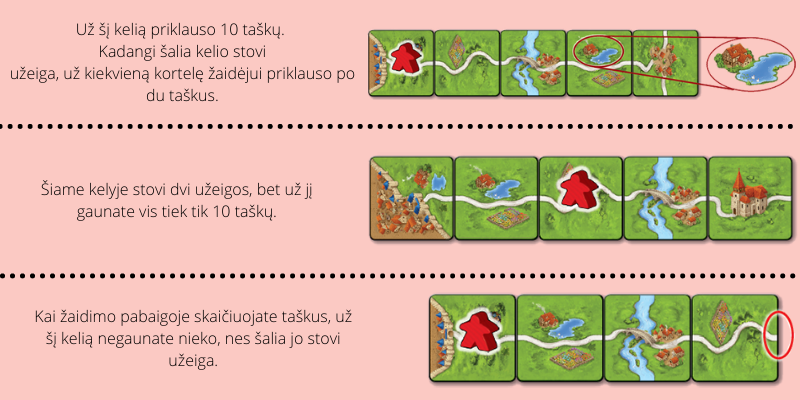
City with a cathedral
- When a player completes a city containing a cathedral, he receives three points for each city card;
- When there are two or more cathedrals in a completed city, you still get three points for each card;
- If you fail to complete a city with a cathedral, you don't get any points for it.
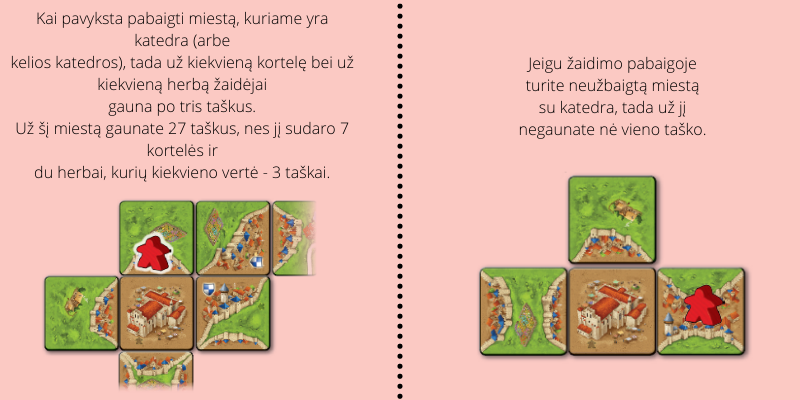
Additional cards
- Four different cities with a field and a garden in the centre.
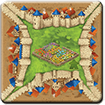
- Tavern next to the road. It belongs to only two roads: one going left and one going right from the intersection. The road going down does not have an inn.
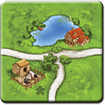
- On this card, the monastery separates two roads.

- In this card, we see that two cities merge to separate the fields.

- An intersection separates two roads. Subordinates can only be placed on the road going up and the road going down. Left and right roads do not count as game pieces. They simply divide the field into two parts.
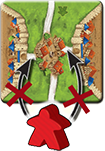
Point cards
Playing this variant of the game increases the final number of points you can score. Players can then go around the scoring board once or several times. When someone passes the circle once, they place a scorecard in front of them, face up with the number 50. When the circle is passed twice, the card is placed with the number 100 face up. If the circle is passed a third time, the player takes another point card and places it in front of him. At the end of the game, the amount on the face-up card is added to the point value on which the player's piece stands. 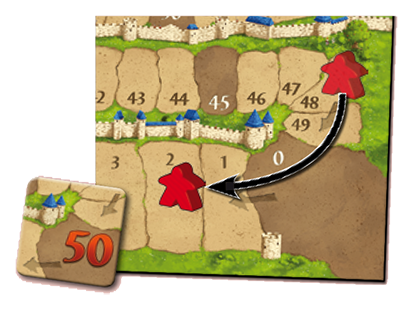
Carcassonne expansion - Traders and Builders
Game set
- 24 land cards:
- 9 with pictures of wine barrels;
- 6 for cereals;
- 5 - Materials;
- 20 goodie markers:
- 9 wine barrels;

- 6 grains;

- 5 materials;

- 9 wine barrels;
- 6 construction workers;

- 6 piglets;

- 1 bag for storing the game components and drawing cards.
Game rules
All the cards are turned over and shuffled. Separate the mushroom cards into three piles and place them in a place that is easily accessible to everyone. To help distinguish this Carcassonne expansion and its cards from the others, a piglet badge is shown on each card. 
Additional cards
- New bridge cards appear. These are not junctions. Roads simply go over the top or bottom of the bridge and continue on. The two roads that cross the bridge divide the field into four parts.

- We see two roads and a bridge. One road ends at the town and the other at the lodge. These roads divide the field into three parts.
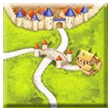
- The monastery separates the roads. Here we see three different roads and three different fields.
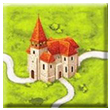
- Here we see three different cities. In between is a field. A peasant can be placed here, and if these cities are completed, the peasant will get points for all of them.
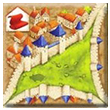
Fungus markers 
These cards only affect the calculation of points for completed objects. The other actions are unchanged.
Scoring for a city with a goodies icon
Any player can complete such a city. Points are then scored:
- For a city, we calculate points as normal.
- The goods in a city do not necessarily go to the owner of that city. They go to the one who completes the city, even if he has no subordinates in that city. Such a person receives a card or cards of the relevant goods. As many goodies as there are in the city, that is the number of cards the player who completes it receives.
- Place the goodie cards in front of you so that everyone can see how much you have and what you have.
Counting points for goodies
- We count the points for goodies at the end of the game.
- The player who has the most of one type of goodies receives 10 points.
- When several players have the same number of goodies, they all get 10 points.

Builders
These pieces have no influence on the card placement and scoring phases. Therefore, we will only discuss the action of placing the builder on the card.
Building a builder
- You can build a builder on a city or road card that has just been placed. It is important that there is already one subordinate figure on the object.
- When you finish the object and take your pieces off it, you take the builder with you.
- When you attach a card to an object on which a builder is standing, you can draw the card again. A third card can no longer be drawn.
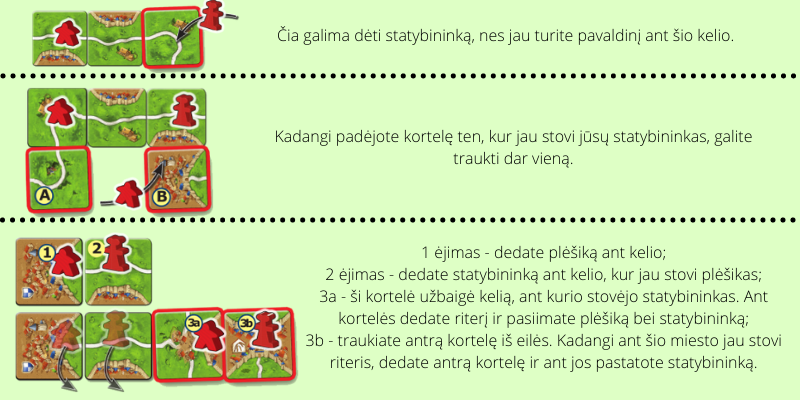
Important!!!
- The builder must stay where he or she is built until the site is completed. Only then can he be removed with his subordinates. As long as there is at least one subordinate on the site, the builder must also remain there;
- After the second card is drawn, you must complete all three actions: placing the card, placing the slave, and counting the points for the completed passage;
- Several builders may be working on one object;
- The number of cards separating a subordinate and a builder is irrelevant;
- You can only build a builder on roads and towns. They cannot be built on monasteries and fields;
- Points for a completed fragment can be counted each time you place the card and complete the object.
Piglet
Piglets have no role to play in the laying phase.
Building a piglet
You can only build a piglet in a field where your peasant is already lying. Piglets are not placed on other objects.
Scoring with a piglet on the field
- The piglet, like the peasant, stays outside until the end of the game.
- The piglet brings extra points, but only in fields where your peasants outnumber other players. If you and another player have the same number of peasants and all other players have fewer peasants, then the piglet will also score points. Just remember that the piglet itself is not counted as a peasant.
- A player with a piggy bank receives four points for each completed city in that square, instead of three.

Game bag
To avoid having to stack the land cards in piles on the table, you can simply place them in a bag and then pull them out one by one. Each Carcassonne Addendum adds extra cards, making it much more convenient to use the bag when playing.





